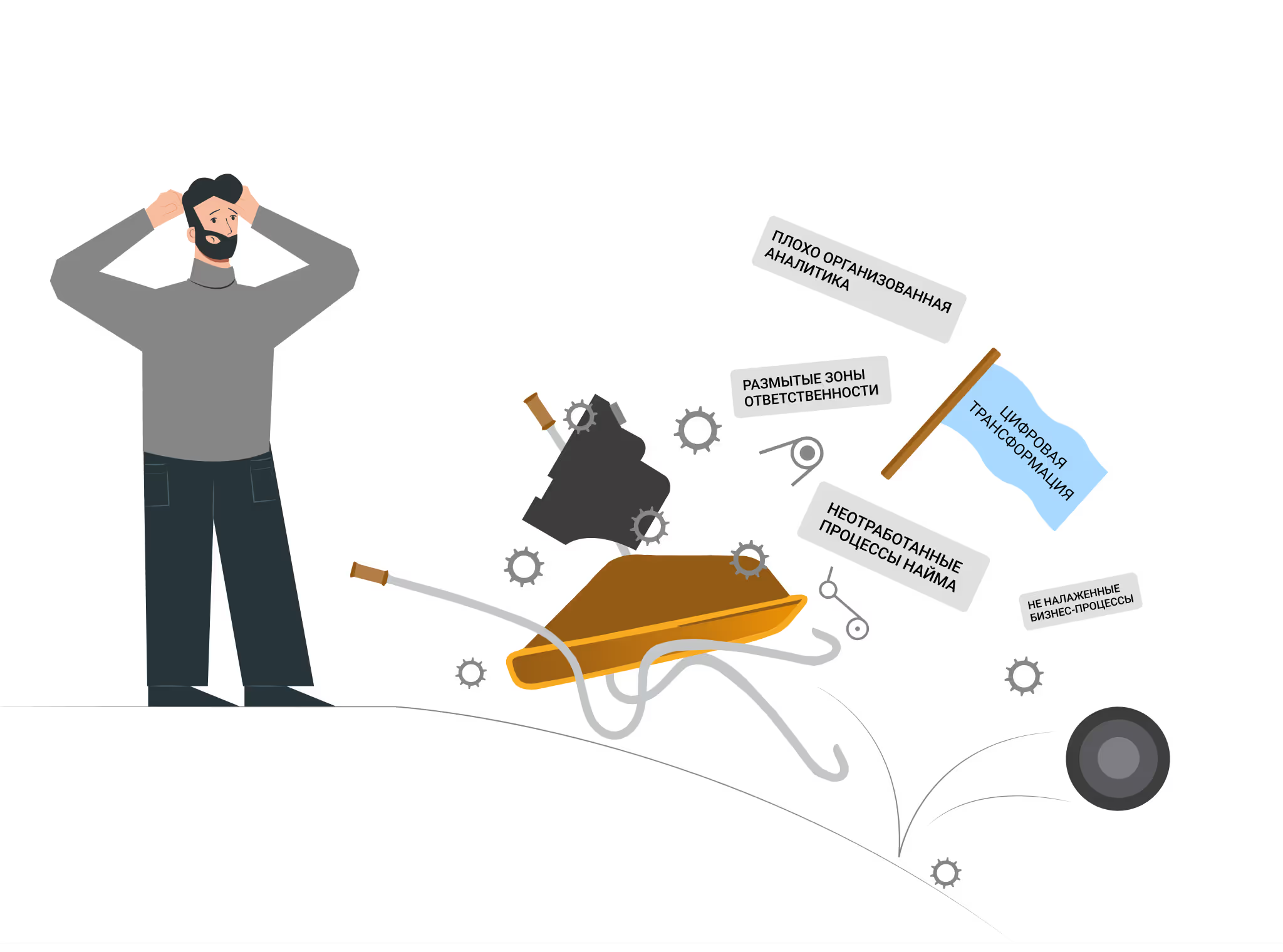Businesses enter the process of transformation with dreams of a great digital future, but without understanding exactly how, in numbers and processes, they will benefit from specific technologies.
At KT.team, we have participated in the digital transformation processes of many organizations. I studied this process both in terms of IT and, as a business owner, in a management focus. In this article, I, Andrey Putin, CEO of KT.team, will talk about a number of criteria that will help you understand whether your company is ready for digital transformation and what needs to be fixed in order to get the most out of the technologies being implemented. Everything that is written in this article has been repeatedly confirmed in practice by our own experience and by the observations of heads of large firms around the world.
Expectations: a couple of implementations left before takeoff
In the manager's opinion, the business as a result of digital transformation looks perfect:
- the cost of basic (and even more so non-core) processes is decreasing;
- all processes are transparent and controlled;
- You can change or create any process in a few clicks;
- productivity increases;
- customer feedback is fast and uninterrupted.
And since one of the goals of business is to make a profit, it is desirable that every ruble invested in digital transformation pays off tens and hundreds of times.
It looks like a plan. To implement it, you need to select a few of the right technologies or IT products and implement them. Technology has never been as accessible as it is today in human history, which means that there should be no problems with digital transformation. Then why does it fail 70% of the time?
Reality: technological weights and millions in losses
Business approaches the choice of technologies to be implemented pragmatically: it studies functionality, analyzes similar cases, and tries demos. After such a rigorous selection, it is logical to expect miraculous transformations from technologies. But the miracle doesn't happen — either the technology was chosen incorrectly and needs to be replaced, or another technology is needed to get results. And one more. And one more thing.
The result is companies with dozens of huge IT projects and expensive systems, but with a clear lack of ability to change. By focusing on specific IT solutions, enterprises get technological weights, not wings.
The reason is simple. Technology is a jet engine. Expensive, useless in itself, and — if not properly installed — even dangerous. If you buy it for a cart, not for a rocket, a lot of money will be wasted: the cart won't take off anyway, and the engine in the garage will rust like a monument to excessive optimism.


But if before the digital transformation, the organization had already taken the form of a rocket, rocket processes, the internal structure of the missile and the missile crew are quite another matter, and a digital transformation jet engine will really help this company make a breakthrough. This means that before launching a digital transformation project, it makes sense to make sure that your business is ready for it, otherwise you will need to work out the weaknesses you have discovered in advance.
Four signs your company isn't ready for digital transformation yet
Let's figure out what the company needs to fix before embarking on digital transformation. However, even if your immediate plans do not include a digital transformation project, understanding the current state of the firm on these five points will help make your business more efficient.
1. Lack of a process approach to management
From the point of view of the process approach, a company is a set of interrelated business processes: from the main process to executive level processes (“pick up, sign — transfer”).
If your company's processes are spelled out — in BPMN notation and mental maps — you, as a manager, get an understandable and transparent management and control tool. Employees also have a better understanding of their tasks and the sequence of actions within each process.
When processes are not spelled out, you face the following inhibitory factors.
Long, useless talks and instructions. Managers and employees do not know how to carry out work procedures in a common language and cannot reduce the small details of the project into simple and understandable schemes. Because of this, negotiations on any issue take days, and the total length of instructions amounts to thousands of pages.
For example, there is a task to check the operation of the equipment. This is just one of the company's hundreds of business processes, but in an organization without process management, it will be presented in the form of a 15-page instruction.

Intuitive solutions. The manager wants to get the product to market faster, but doesn't know where the bottleneck is in the process and how this process works step by step. Therefore, instead of a specific improvement, the project team will select some popular “silver bullet of mass destruction” type of PIM system on the market.

As a result, the task of “accelerating the introduction of goods to the market” will be replaced by a simpler and more understandable “implement a PIM system”. During the year, the manager will receive cheerful reports on the implementation process and sign regular invoices. And the time frame for bringing goods to the market will remain the same at best.
When using the process approach, the launch of a new product is a business process divided into specific stages with clear implementation deadlines and clearly defined areas of responsibility for employees. Based on this business process, it is possible to make substantive decisions.
-03.avif)
2. Vague areas of responsibility for IT systems
If processes are not defined and delimited, they may be partially or fully linked to one IT system. For example, the same Bitrix will be used simultaneously by HR, production, sales, purchasing, marketing, etc. Who would be responsible for the system then? Everyone — and no one in particular. As a result...
Conflicts between departments. Employees spend time sorting things out and defending their area of responsibility, trying to push responsibility to another department. “So as not to offend anyone,” instead of real problems, he discusses the color of the next button, rather than really necessary system improvements.

3. Lack of useful analytics
Companies without clear business processes and areas of responsibility do not have clear performance criteria available to all departments; they do not have clear metrics and collection methods. On the other hand, there are overcomplicated BI or DWH-systems: you need analytics, and if it's hard to read, you need to collect even more data and group it in every possible way in search of patterns.
But since the collection process is complicated and the methodology is not transparent, these systems are not widely used. They only give a false sense of control instead of real benefit.
Digital transformation can accelerate data collection, but to do this, the organization must initially have a habit of collecting and analyzing information in a targeted manner. And the simpler and more understandable the collection and analysis methods are, the better.
4. Undeveloped recruitment and development processes
If your firm has process management, well-defined areas of responsibility, and good analytics, you need the right people to manage change.
And these people should be selected with a clear understanding: what hard/soft skills are needed for each specific position and how these skills should be identified during the hiring process, as well as how employees should be further trained and why they should be fired. Otherwise, it will be difficult for you to hire a qualified employee and even more difficult to fire an unqualified person, because you will not understand who “a sufficiently qualified employee for such and such a position” is either.
As a result, the HR department will only make decisions based on beautiful resumes.
You know how this usually ends.
The bottleneck of a company without well-established hiring processes will not be software or insufficiently disruptive technologies. The bottleneck will be not having the right people in the right positions doing the right thing.
Which company is ready for digital transformation
In summary, we will briefly list the features of an organization that can benefit from the latest technologies without losing money.
- Established processes. Managers are able to combine project details into simple schemes and make decisions based on real business needs. Detailed algorithms for hiring and developing employees are steadily adding qualified personnel to the staff.
- Transparent organizational structure. The areas of responsibility are strictly divided between departments; they do not raise questions and do not provoke conflicts. Managers clearly understand what they are responsible for and perform appropriate tasks. For example, we are in KT.team we use it for this Hubbard organizing scheme.
- Each department has simple and clear metrics. All employees understand how their performance is measured and how to improve it. Analytics is organized as simply as possible.
- Understanding the main goal. Management and managers are well aware of why businesses need digital transformation and how it will help the company achieve its mission.

After reading this article, you may realize that your firm is not yet ready for digital transformation. And that's a good thing. Understand this better before beautiful IT product sites and generous promises from IT integrators force you to exchange your valuable millions so that someone can effectively speak at a conference with your case study.
Take a break to build processes and develop metrics. This will take a little over a year, but then the level of micromanagement will noticeably decrease. It will be replaced by a clear understanding of which direction to move, what results need to be achieved, and how digital transformation will help with this.



.avif)




